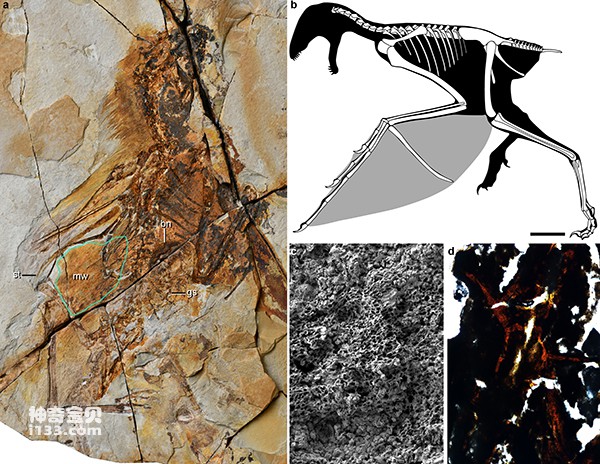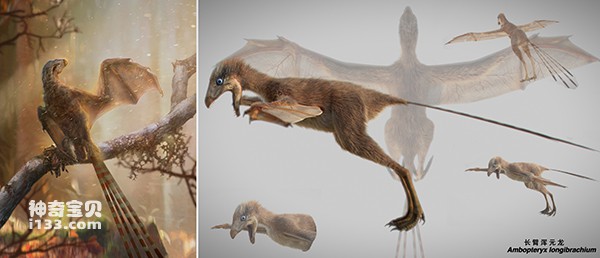In 2019, Nature published a cover article on the research results of Wang Min, Zou Jingmei, Xu Xing, Zhou Zhonghe from the Institute of Vertebrate Paleontology and Paleoanthropology, Chinese Academy of Sciences: Jurassic ornithosaurs reveal the role of membranous wings in dinosaurs The evolution of dinosaurs and birds showed a large number of unexpected attempts to adapt to flight during the evolution of dinosaurs and birds, and correspondingly, significantly different combinations of bone-cuticle derivatives evolved.
In the long evolutionary history of vertebrates, pterosaurs, birds and bats independently evolved different flight structures. Compared with the incomplete fossil records of pterosaurs and bats, with the continuous discovery of feathered dinosaurs and early bird fossils, especially the Yanliao Biota of the Middle and Late Jurassic in my country and the Jehol Biota of the Early Cretaceous , important scientific progress has been made on the important scientific issue of the origin of bird flight, and the discovery of ornithosaurs that are good at climbing revealed "an incredible journey to conquer the blue sky." Scansoriopterygidae is the most bizarre group of dinosaurs. It lived in the Middle to Late Jurassic. Only three species have been discovered so far: Epidendrosaurus Ningchengensis and Yaosaurus Hu. (Epidexipteryx hui) and Yi qi. The ornithosaurus has special shapes, such as a tall skull, slender limbs, elongated third finger (outermost finger), ancient 2-3-4 finger pointing pattern, shortened tailbone, etc. It is like a "mixture" of dinosaurs and birds. body", and it was once considered the most closely related theropod dinosaur to birds. However, the above-mentioned specimens may be incomplete, or they may belong to juvenile individuals, and a large number of morphological characteristics are difficult to observe, making its position on the evolutionary tree confusing. The strange pterosaur named by Xu Xing et al. in 2015 adds more mystery to this group. The forelimbs of Chiropterus were attached with wing membranes and also had a rod-shaped long bone. This long bone has no corresponding homologous structure in other dinosaurs (including birds). As a result, Chiropterus was restored to have membranous wings similar to pterosaurs and to be able to glide. However, there is only one specimen of Akipteryx, which is incompletely preserved, so there is still controversy about the structure of the rod-shaped long bones and wing membranes.
In 2017, the Basic Science Center team led by Zhou Zhonghe obtained a new fossil while investigating the Late Jurassic strata in Liaoning. After a year of indoor repairs, experiments and comparative studies, the research team believed that it represented a new type of ornithosaur and named it Ambopteryx longibrachium (meaning the membranous wings of a pterosaur). and dinosaur). Hunyuanosaurus was discovered in the Haifanggou Formation in the early Late Jurassic of the Yanliao Biota (approximately 163 million years ago). Its holotype is the most complete ornithosaur fossil known so far, providing a large number of morphological and Ecological information. Hunyuanlong is about 32 centimeters long and weighs about 306 grams. Hunyuanosaurus is obviously different from other climbing ornithosaurs in the shape of the proximal humeral joint surface, fingers and belt, and has a caudal bone like a primitive bird. Such a shortened tail bone can further move the body's center of gravity forward, which is beneficial to Stay stable while flying/gliding. More importantly, researchers found rod-shaped long bones and wing membranes in Hunyuanosaurus that are similar to those of Qipteryx (chromatophores are preserved in the wing membranes). This new discovery is that the rod-shaped long bones and wing membranes are in Shanpanniao The appearance of dragons provides unmistakable evidence. The body of Hunyuanosaurus contains gastroliths and bone gastric contents that are suspected to have not been fully digested. This is the first evidence related to the feeding habits found in Shanpansaurus. Researchers speculate that it was omnivorous.
The forelimbs of Hunyuanosaurus were unusually elongated, even longer than most birds in the Mesozoic Era. When researchers compared the forelimbs of dinosaurs, they found that the proportions of the forelimbs of Shanpanornithosaurus were very strange. Is this difference related to the appearance of wing membranes? In order to confirm this speculation, Wang Min et al. used the principal component analysis method based on phylogenetic relationships to discuss the evolution of limb length in Mesozoic coelurosaurs (including birds), especially what significant changes occurred near the origin of flight. Phylogenetic principal component analysis eliminates kinship relationships in traditional principal component analysis to ensure the independence of sampling points to the greatest extent, while restoring the characteristic status of ancestral nodes, thereby showing the evolutionary trends of different taxa. The results of the study show that starting from the Paraves (the broadest group including all birds but excluding oviraptorosaurs), the forelimbs began to lengthen, but only the celestialsaurus had a lengthening degree close to that of Mesozoic birds , and this level has never been obtained by other non-ornithosaur dinosaurs. The lengthening of the forelimbs in Ornithosaurus is mainly derived from the humerus and ulna; in birds, dromaeosaurs or troodontids, it is the lengthening of the metacarpal bones, and the forelimbs of these groups have flight feathers. Researchers believe that Ornithosaurus attached its membranous wings through an elongated humerus and ulna, a third finger, and a rod-like long bone, while birds, dromaeosaurs, and troodontosaurs needed longer metacarpal bones to attach the wings. Feathers, showing two different flight modes—"membranous wings and short metacarpals" and "feathered wings and long metacarpals"—produced dramatic changes in the structure of the forelimbs.
All known ornithosaurs lived in the Late Jurassic, and similar membranous wings did not appear in Cretaceous dinosaurs. Wings composed of flight feathers lasted from the Late Jurassic to the Cretaceous. After a long evolution, they eventually formed the wings of birds, making the latter the most diverse living quadruped. The unique flight structure of Ornithopteryx represents a brief attempt at the evolution of flight.
This research was supported by the Basic Science Center Project of the National Natural Science Foundation (Cratonic Destruction and Terrestrial Biological Evolution), the Outstanding Youth Science Fund Project, the Youth Innovation Promotion Association of the Chinese Academy of Sciences, and the State Key Laboratory of Lithosphere Evolution (North China Craton Destruction and Yan Supported by the evolution of the Liao-Jehol biota).
Original link: https://www.nature.com/articles/s41586-019-1137-z

Figure 1. Cover of the current issue of "Nature" magazine: Jurassic dinosaur with membranous wings discovered in ancient vertebrae

Figure 2. a, The holotype specimen of Hunyuanlong long-armed; b, Skeletal restoration; c. Membranous wing membrane chromatophores; d. Bony stomach content tissue section. bn, ;Bony stomach contents; gs, Gastrolith; mw, Membranous wing membrane; st, Rub-shaped long bone. (Photo provided by Wang Min)

Figure 3. Phylogenetic tree and limb bone evolution of Mesozoic coelurosaurs: At the origin of flight, different taxa of parabirds showed different forelimb lengthening processes: Phytophora ornithosaurus lengthened the humerus, combined with a third finger and a club Long bones attach membranous wings; while dromaeosaurs, troodontids, and birds attach feathery wings through the lengthening of metacarpal bones (photo provided by Wang Min)

Figure 4. Restored picture of Long-armed Hunyuanlong (photo provided by Zhang Zongda)
animal tags:
We created this article in conjunction with AI technology, then made sure it was fact-checked and edited by a Animals Top editor.